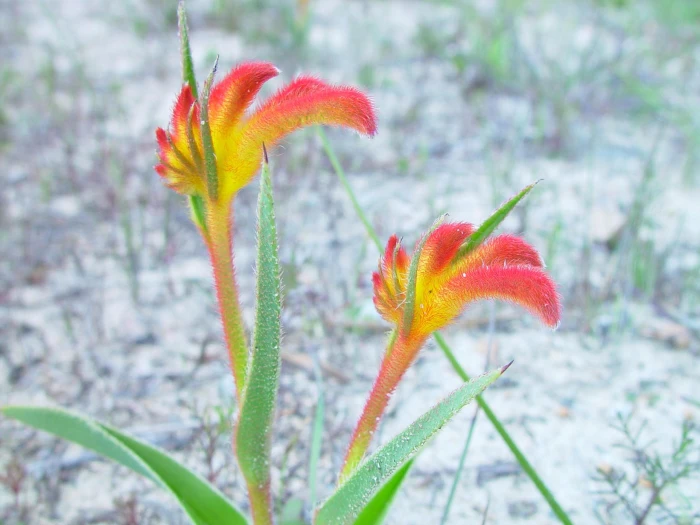Little Kangaroo-Paw
(Anigozanthos bicolor)
Little Kangaroo-Paw (Anigozanthos bicolor)
/
/

Leon Brooks
Public domain
Image By:
Leon Brooks
Recorded By:
Copyright:
Public domain
Copyright Notice:
Photo by: Leon Brooks | License Type: Public domain | License URL: https://creativecommons.org/public-domain/ | Uploader: Fæ | Publisher: Wikimedia Commons | Title: Kangaroo_paw_flower_anigozanthos_bicolor.jpg | Notes: {{Information |Description={{en|1=Custard-apple, sugar-apple, sweetsop, sitaphal or Sita's fruit, shareefah, aataa or Rahmapfel ''[[Annona squamosa]]'' in [[Hyderabad]] , [[India]].}} |Source=Own work by uploader |Author=[[User:J.M.Garg|J.M.Garg]] |Date=1
























Estimated Native Range
Climate Requirements
| • Precipitation | 22" - 27" |
| • High Temp. | 78°F - 91°F |
| • Low Temp. | 42°F - 47°F |
Summary
Anigozanthos bicolor, commonly known as Little Kangaroo-Paw, is an evergreen perennial herb native to the sandy plains, heathlands, and open forests of Southwestern Australia. It typically grows to a height and width of 1-2 feet (0.3-0.6 meters). This species is characterized by its tubular, two-toned flowers, which are green and red, resembling the paws of a kangaroo, and bloom in the spring and fall. The flowers are quite showy and attract nectar-feeding birds. Little Kangaroo-Paw has strappy green leaves and a clumping habit, making it an attractive ornamental plant.
Little Kangaroo-Paw is valued for its unique flowers and ability to attract wildlife. It is often used in ornamental gardens, borders, and as a container plant. It requires well-drained sandy or loamy soil and thrives in full sun, although it can tolerate partial shade. While drought-tolerant once established, it benefits from occasional watering during prolonged dry periods. It is relatively low maintenance but can be susceptible to ink disease, which causes blackening of the leaves. To prevent this, ensure good air circulation and avoid overhead watering. There are no major concerns regarding invasiveness or aggressive roots.CC BY-SA 4.0
Little Kangaroo-Paw is valued for its unique flowers and ability to attract wildlife. It is often used in ornamental gardens, borders, and as a container plant. It requires well-drained sandy or loamy soil and thrives in full sun, although it can tolerate partial shade. While drought-tolerant once established, it benefits from occasional watering during prolonged dry periods. It is relatively low maintenance but can be susceptible to ink disease, which causes blackening of the leaves. To prevent this, ensure good air circulation and avoid overhead watering. There are no major concerns regarding invasiveness or aggressive roots.CC BY-SA 4.0
Plant Description
- Plant Type: Herb, Subshrub
- Height: 1-2 feet
- Width: 1-2 feet
- Growth Rate: Moderate
- Flower Color: Red
- Flowering Season: Spring, Fall
- Leaf Retention: Evergreen
Growth Requirements
- Sun: Full Sun
- Water: Low, Medium
- Drainage: Medium, Fast
Common Uses
Bird Garden, Low Maintenance
Natural Habitat
Sandy plains, heathlands, and open forests of Southwestern Australia
Other Names
Common Names: Two Coloured Kangaroo Paw
Scientific Names: Anigozanthos bicolor
GBIF Accepted Name: Anigozanthos bicolor Endl.